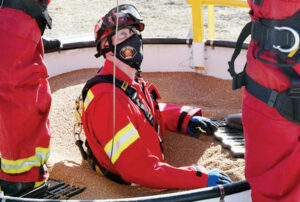Magrath Fire Department train for grain bin rescues
By Herald on March 31, 2021.
 The Magrath Fire Department, in conjunction with Canadian Agricultural Safety Association, Alberta Wheat and various partners and sponsors, hosted a grain bin rescue course last Saturday, March 20, which saw personel from the Cardston Fire and Blood Tribe department participate. Southern Alberta Newspapers photo by Nikki Jamieson
The Magrath Fire Department, in conjunction with Canadian Agricultural Safety Association, Alberta Wheat and various partners and sponsors, hosted a grain bin rescue course last Saturday, March 20, which saw personel from the Cardston Fire and Blood Tribe department participate. Southern Alberta Newspapers photo by Nikki JamiesonNikki Jamieson – Southern Alberta Newspapers
The Magrath Fire Department hosted a grain bin rescue course just outside of the Town of Magrath earlier this month. The all-day event, held in conjunction with the Canadian Agricultural Safety Association, Alberta Wheat and various other partners and sponsors, saw groups of firefighters from Magrath, Cardston and the Blood Tribe learn how to safely extract someone trapped in grain.
A special safety trailer travels to different communities and offers firefighters a hands-on training experience on safely extracting someone trapped in grain.
Sean Stanford, a captain with the Magrath Fire Department who owned the farm where the training took place, called the exercise a great opportunity, and they were able to take advantage of funding from the Alberta Wheat Commission to put on the training program.
“I’ve been on the fire department for quite a few years now, and luckily, we haven’t needed to use any of this equipment yet or we haven’t needed this sort of service, but to have it now is going to be a benefit in case something does happen to either myself or somebody down the road, one of my farming neighbours, it’s going to be a big benefit,” said Stanford.
People can get trapped in grain bins in many different ways, such as going into a clear grain bin and getting stuck on the side of the bin — only for it to collapse on top of you or falling through a hard crust of grain on top after going into a bin.
The grain compresses against the body, making it hard to move and, depending on how high it goes up a body, hard to breathe.
“I’ve see training videos of it before, but to actually see it in-person is a little different,” said Stanford.
For the course’s instructor Tom Littlechild, regional technical advisor of community and technical support for Municipal Affairs and a member of the Siksika First Nations fire department, grain safety is personal.
Having grown up on a farm, his father had got trapped in a grain bin up to his chest.
“Back then, we didn’t have any of this stuff we have here. Luckily, we did get him out, and we were very fortunate the grain bins that we did have back then were (smaller),” said Littlechild. “We got lucky, let’s put it that way.”
Magrath fire chief Cliff Blackwell, who acted as an entrapped person during the training exercise, said he found once he was buried up to mid-thigh he was unable to move and could no longer get out by himself.
The process of extracting someone safely from the grain involves locking out all components to ensure nothing turns on while in the bin, then placing platforms on top of the grain to move around on before assessing the entrapped person and getting them into a harness.
Metal panels called cofferdams are placed around the entrapped person and driven down into the grain to help relieve the pressure before a pencil auger is placed inside the enclosure to suck grain out of the space to further reduce pressure and help remove them from the entrapment.
Training exercises like this help the Magrath Fire Department respond to and assist those living in more rural areas. “There are a lot of hazards and dangers of working on a farm,” said Blackwell.
“We’re grateful our farmers are very conscious and very careful. However, we’re also grateful we have companies like this and (BeGrainSafe) and the Canadian Agricultural Safety Association, Alberta Wheat and (others), that have come in and given us the ability to come in and get the training that can help in an emergency like this.”
While grain entrapments are not a common call, Blackwell said it was better to train for the extreme case.
The message for those working in and around grain bins was to ensure all electrical equipment tagged out and locked out, so nothing starts up while in a bin. And most importantly, to never work alone.
“There’s a lot of grain bin entrapments, more than people know, it’s quite a common occurrence unfortunately across North America.
“The biggest way to avoid it or prevent it from happening is working with somebody else, but unfortunately — I get it, I grew up on a farm — there’s a lot of people who do farm out here, they’re out there by themselves and when they’re by themselves, when incidents occur, and unfortunately, that’s when people don’t know that something happened,” said Littlechild.
“The best way to prevent it is to be working as a team, or letting somebody know what you’re doing.”
In 2015, there were some fatal accidents involving farmers and grain bins, including three children who died after getting caught in a grain trailer.
After that, farming associations began discussing what can be done to help promote and improve safety around grain.
CASA’s BeGrainSafe program was created in response to the rise in grain entrapment fatalities, and since 2017, has promoted grain safety with displays, demonstrations, producer education and firefighter training. The trailer, with a built-in silo that can hold 7,000 pounds of grain, has been used to demonstrate grain entrapment and to help train firefighters.
-2


